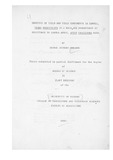| dc.description.abstract | Cowpea (Vigna unguiculata (L.) Walp) is grown in Kenya as a grain legume and a vegetable crop. The local cultivation is mainly of landraces with minimal genetic improvement on yield and its components. Cowpea research in Kenya is aimed at improving yield, earliness and,disease and insect resistance. The cowpea aphid,
Aphis craccivora Koch, is a pest of cowpea that is growing rapidly in importance. Its destruction is more serious in the semi-arid areas. Separate trials were conducted for genetic studies of grain yield and its components, 100-seed weight, number
of seeds per pod, pod length,peduJlcle length, number of pods per plant, peduncles per plant and pods per peduncle, and earliness characters, days to first flowering and
days to maturity, and for inheritance of resistance to A. craccivora. A 5 x 5 diallel consisting of three local varieties, lCV 1, lCV 6 and rCV 10; one irradiated mutant, lCVll and one exotic variety, TVU310 was used to evaluate for combining ability and heterosis for grain yield and its components. The diallel analysis of Griffing (1956b) riethod 2 model I was adopted in estimating the combining abilities. A single row plot of each of the 10~s and 5 parents were planted in a randomised complete block design with four replications in the field in March 1985 at the International Centre of Insect Physiology and Ecology (ICIPE), Mbita Point Field Station, South Nyanza. Data were collected on five randomly selected plants per plot. Combining ability analysis showed the importance of both additive and non-additive gene action for the variability in grain yield per plant, lOO-seed weight, peduncle length, number of pods per plant and peduncles per plant, though the magnitude of additive gene variance was greater in the case of lOO-seed weight and peduncle length. Number of seeds per pod, pod length, pods per peduncle, days to first flowering and days to maturity were predominantly under additive gene action. The
exotic variety, TVU3l0 was found to exhibit positive GCA in more characters than the other varieties and also involved in good specific combinations. Heterosis was
observed for grain yield per plant, number of pods per plant and peduncles per plant. The ~ se performance of the parents was considered an adequate measure of the
GCA values of the varieties. Phenotypic and genotyptic correlation coefficients
were calculated from variance and covariance analyses for all possible combinations of characters. The phenotypic and genotypic correlations agreed closely in most comparisons. Important positive correlations were observed between grain yield per plant and number of seeds per pod, pod length, pods per plant and peduncles per plant. lOO-seed weight was positively correlated with seeds per pod, pod length and peduncles per plant but negatively with peduncle length and pods per peduncle. Very high correlation was noted between number of seeds per pod and pod length, pods per plant
and peduncles per plant, and between days to first flowering and days to maturity. Negative correlations were present between pods per peduncle and days to first
flowering and days to maturity, and between peduncle length and days to first flowering and days to maturity. Path-coefficient analysis technique was employed to establish the relative importance of grain yield characters as determiners of grain yield per plant.
Direct effects of number of seeds per pod and pods per plant were considerable. Indirect effect of pod length on yield via seeds per pod was positive and considerable.
The three characters, number of seeds per pod, pods per plant and pod length were observed as reliable components of yield for a cowpea improvement programme.
For the study of inheritance of resistance to the cowpea aphid, A. craccivora, five sets of crosses, ICVl x TVU310, lCVI x "lCVII, :ICVIO x lCVJ!l,lCV llx TVU3l0 and ICVlO x TVU3l0 were utilized. The experiment was conducted in the screenhouse. Three-day old
seedlings of parents , PIs, 'PZs and backcross (whereapplicable) were infested with 10 adult aphids per seedling. Seedling reaction 10 days after infestation,i.e., survival (resistance) or death (susceptibility) of the parents, PIS, PZs and backcross populations
indicated resistance to be dominant over susceptibility, and that resistance was conferred by a single gene. However, the resistance genes in these parents were different. One dominant gene ACI was identified in both ICVlO and TVU3l0 varieties and the other gene ACZ in the mutant variety, ICVll. The two dominant genes were non-allelic located in the same chromosome distant apart or in different chromosomes. The two genes may be
duplicate confering the same level of resistance as any combination or with cummulative effects. The resistance in any of the three parents could be transferred to a susceptible, locally adapted cultivar by use of the backcross pedigree method. | en |

